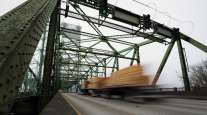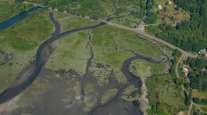Senior Reporter
2021: Year of the $1 Trillion Infrastructure Law

[Stay on top of transportation news: Get TTNews in your inbox.]
A long-awaited federal bill that will fund upgrades to the nation’s highway infrastructure was finalized during 2021, the culmination of tough legislative effort and a welcome outcome for trucking.
After nearly a year of negotiations, Congress passed a $1 trillion infrastructure policy bill, which President Joe Biden signed into law Nov. 15. The law, which proponents describe as a transformative policy achievement, promises to modernize every corner of the transportation network.
Two weeks after enacting the Infrastructure Investment and Jobs Act into law on the White House lawn, Biden traveled to the Dakota County Technical College in Rosemount, Minn., to explain provisions pertaining to freight connectivity, climate change, and electric vehicle technology. The visit also kicked off what would become a series of victory laps for Biden and his senior staff, who continue to celebrate the realization of one-half of the president’s Build Back Better agenda.
The other half, a nearly $2 trillion social infrastructure budget, awaits consideration in the U.S. Senate.

“We know that we can’t just build back to what it was before. And that used to be the rule. If anything got wiped out by a weather event, you were able to build back that road at exactly the specifications it was before,” Biden said in Minnesota on Nov. 30. “But you can’t now because the climate is not going to get better. It’s — hopefully, we’re not going to get worse. But you’re going to have to build that road a couple of feet higher. You can’t build it back to what it was. You can’t replace those high power lines that come down with the same kind of construction. They have to be built so they’re more resilient.
“The law brings the White House back to the days when previous administrations pursued transformative policies and ideals, such as the Rooseveltian New Deal and Eisenhower’s interstate highway system. So that’s what I mean when I say ‘build back better.’ It’s necessary.”
Its infrastructure funding provisions are designed to pave the way for upgrades to traditional highway and transit projects while incorporating futuristic initiatives capable of propelling climate change-centric resilient programs.
The administration’s focus on infrastructure gained popularity and support from unions, the manufacturing sector and the freight industry. These stakeholders had advocated for colossal investments in infrastructure projects for more than a decade.
Those lawmakers who put their constituents before themselves have now cemented a lasting legacy.
American Trucking Associations President Chris Spear
“Roads and bridges are not political — we all drive on them. A majority in the House and Senate realized this truth and did what’s right for the country, not themselves,” American Trucking Associations President Chris Spear said soon after the bill’s enactment. “From farmers to truckers, the millions of hardworking people who make this country great won today. Those lawmakers who put their constituents before themselves have now cemented a lasting legacy that the American people will see, feel and use for many decades to come.”
Spear emphasized: “After countless hearings and meetings on Capitol Hill, ATA members will finally see the fruits of their labor — a 38% increase in road and bridge funding, and an infusion of highly trained, younger talent into our workforce.”
The U.S. Chamber of Commerce, the American Society of Civil Engineers and the American Association of State Highway and Transportation Officials shared a similar sentiment.
As the law’s title suggests, creating jobs in a greener economy meant to revitalize a sagging economy is central to the law’s objective. Addressing climate change is a key part of that aim, as evident by establishing a network of electric vehicle charging stations.
The White House recently outlined a road map for encouraging state agencies to construct about 500,000 charging stations for electric vehicles. The move is designed to help achieve net-zero carbon emissions by 2050.
Specifically, the law includes $5 billion to facilitate how states build a national charging network. It also dedicates $2.5 billion for a grant program to back innovative approaches in rural electric vehicle charging, local air quality improvements and charging access in economically disadvantaged areas.
The White House indicated on Dec. 13: “With the historic investments in the bipartisan infrastructure law, the Biden-Harris administration is laying the foundation for a nationwide network of [electric vehicle] charging infrastructure to provide a reliable, affordable, convenient, seamless user experience that is equitable and accessible for all Americans.”

Granholm
Relatedly, the Biden administration established the Joint Office of Energy and Transportation as a way to enhance the deployment of the national electric vehicle charging network. Energy Secretary Jennifer Granholm and Transportation Secretary Pete Buttigieg were assigned the joint venture. “Transportation is responsible for the most greenhouse gas emissions of any sector in our economy — so it can and must be a big part of the solution to the climate crisis, Buttigieg said Dec. 14. “With this announcement by DOT and DOE, we are taking a big step forward on climate by helping make the benefits of [electric vehicles] more accessible for all Americans.”
For surface infrastructure projects, the law is designed to invest nearly $600 billion on connectivity improvements for highway systems, transit networks, bridges, tunnels, ports, canals, railroads and airports.
Statement from Amtrak Board Chair Tony Coscia on President Biden signing the IIJA: https://t.co/BNKJAZvOYR — Amtrak (@Amtrak) November 15, 2021
A freight component is anchored on rail networks, which the White House indicated “have the potential to offer safe, reliable, efficient and climate-friendly alternatives for moving people and freight.” The law invests about $80 billion in Amtrak, and fortifies federal grant and loan programs targeting freight rail safety.
At least $100 billion would be used for modernizing electric grids. That is partly in response to severe weather events that hit Kentucky, Texas, Louisiana and California, among other places. Another $100 billion is directed for drinking-water infrastructure projects, such as the removal of lead pipes at approximately 9 million home units.
Unlike the American Rescue Plan, which provided $1.9 trillion for COVID-19 pandemic relief efforts, the infrastructure law sparked pushback among progressive Democrats disappointed that climate change was not its absolute focus. At the same time, Republican leaders criticized the law’s scope and source of funding.

Capito
Leading the negotiations for Republicans was Sen. Shelley Moore Capito (R-W.Va.), ranking member on the Environment and Public Works panel with jurisdiction over highway policy. A GOP counterproposal almost reached $600 billion. Ultimately, about a third of Senate Republicans and 13 Republicans in the House voted to pass the infrastructure bill.
“I voted in support of the Infrastructure Investment and Jobs Act, commonly referred to as the bipartisan infrastructure bill,” affirmed Rep. Don Young of Alaska, who was among the Republicans to back the legislation. “Our country is an economic powerhouse in no small part due to our historical support for infrastructure and other surface transportation projects.
“Perhaps more than anyone else, Alaskans know just how vital reliable infrastructure is to stay connected with one another and secure upward economic mobility. But I will be honest: When I take a look at some of our roads, bridges and ports, I do not like what I see.”

DeFazio
The legislation reached the finish line with an assist from House transportation Chairman Peter DeFazio (D-Ore.), who announced he would not seek another term in Congress after more than three decades on the Hill.
“The Infrastructure Investment and Jobs Act is a major victory for the American people, making the largest-ever single investment in America’s crumbling infrastructure. While it doesn’t include exactly the policies or the funding I wanted, the bipartisan bill ushers in a new era for intercity passenger rail,” said the outgoing transportation chairman.
During the law’s negotiations in Congress, the White House set up a “jobs cabinet” consisting of Granholm, Buttigieg, Housing and Urban Development Secretary Marcia Fudge, Labor Secretary Marty Walsh and Commerce Secretary Gina Raimondo.
In his role as a member of the “jobs cabinet,” Buttigieg, formerly a mayor from Indiana and presidential aspirant, embraced the role of infrastructure agenda spokesman.
“With the passage of President Biden’s bipartisan infrastructure law, we will be able to support far more infrastructure projects to support jobs and everyday life in communities across the country,” he noted.
This year, Buttigieg also was among senior administration officials tapped to address growing concerns from freight stakeholders over supply chain bottlenecks. Supply chain woes dominated a considerable amount of the administration’s focus. In addition to setting up a task force to work with private sector firms, the administration redirected federal transportation dollars for port connectivity initiatives.
Additionally, the White House announced it would prioritize near-term modernization and expansion projects for ports essential to freight distribution. It specifically would identify $3.4 billion to upgrade obsolete freight inspection facilities.
Biden, Buttigieg and other officials pointed to the new infrastructure law as a potential source of relief from considerable bottlenecks at commercial ports. The White House attributed the bottlenecks to the COVID-19 pandemic.

Joshi
But the administration’s response to the supply chain crisis, prompted pushback from most congressional Republicans. Sen. Rick Scott (R-Fla.), a member of the Commerce Committee, announced a procedural hold on transportation nominees until Buttigieg and other Cabinet secretaries appear before the committee and respond to his supply chain concerns. The procedural hold halted a vote on Meera Joshi’s nomination to become administrator at the Federal Motor Carrier Safety Administration. She serves as the agency’s deputy administrator.
On the regulatory front, one of FMCSA’s key decisions was to repeatedly extend a suspension of certain hours-of-service rules for truckers assigned to the post-pandemic economic response. The waiver associated with commercial drivers’ maximum driving time for property-carrying vehicles was extended through Feb. 28.
FMCSA explained, “Although the number of COVID-19 cases began to decline in the U.S. following widespread introduction of vaccinations, persistent issues arising out of COVID-19 continue to affect the U.S. including impacts on supply chains and the need to ensure capacity to respond to variants and potential rises in infections.”
Want more news? Listen to today's daily briefing below or go here for more info:





